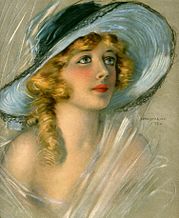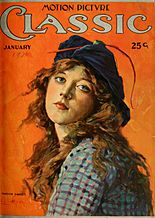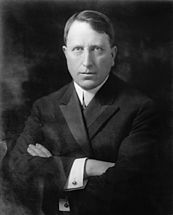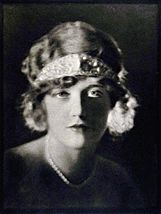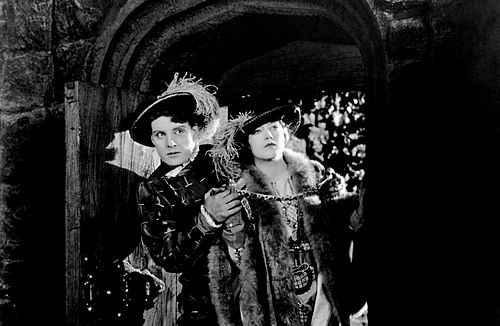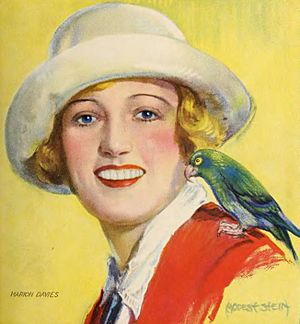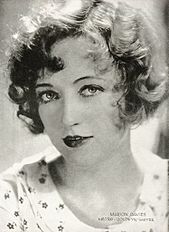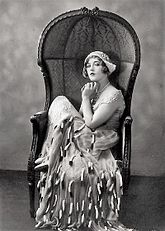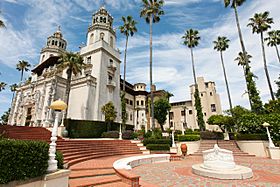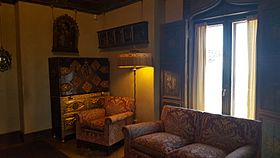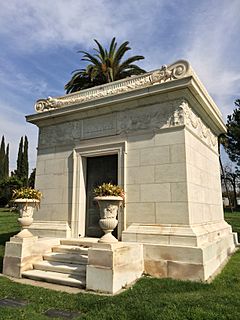Marion Davies facts for kids
Quick facts for kids
Marion Davies
|
|
|---|---|

Davies in the 1920s
|
|
| Born |
Marion Cecilia Douras
January 3, 1897 Brooklyn, New York, U.S.
|
| Died | September 22, 1961 (aged 64) Los Angeles, California, U.S.
|
| Resting place | Hollywood Forever Cemetery |
| Occupation |
|
| Years active | 1914–1937 |
| Spouse(s) |
Horace G. Brown
(m. 1951) |
| Partner(s) | William Randolph Hearst (1917–1951; his death) |
| Children | Patricia Lake (alleged) |
| Relatives | Rosemary Davies (sister) Reine Davies (sister) Charles Lederer (nephew) Pepi Lederer (niece) |
Marion Davies (born Marion Cecilia Douras; January 3, 1897 – September 22, 1961) was an American actress, producer, screenwriter, and philanthropist. She was known for her talent in both dramatic and comedic roles.
Marion went to a religious school as a child. However, she left to become a chorus girl and pursue acting. As a teenager, she performed in several Broadway musicals and one film, Runaway Romany (1917). She soon became a popular performer in the famous Ziegfeld Follies shows.
In 1916, when Marion was 19, she met William Randolph Hearst. He was a very powerful newspaper owner, 53 years old. Hearst became very interested in Marion's acting career. He helped manage her work and promoted her as a film actress.
Hearst used his newspapers and newsreels to promote Marion's films. He even started a movie company, Cosmopolitan Pictures, just to make her movies. By 1924, Marion Davies was one of the most popular female movie stars in Hollywood. Her films like When Knighthood Was in Flower and Little Old New York were huge hits.
During the exciting Jazz Age, Marion became famous for hosting amazing parties. Many Hollywood stars and important political people attended these events. Marion retired from acting in 1937 to care for Hearst, who was getting older. She stayed with him until he passed away in 1951.
Eleven weeks after Hearst's death, she married sea captain Horace Brown. Marion Davies died in 1961 at age 64 from bone cancer.
After her death, many people remembered Marion Davies because of the movie Citizen Kane (1941). In the film, a character named Susan Alexander Kane was thought to be based on Marion. Susan was an untalented singer whom the main character tried to make famous. However, many people, including the film's director Orson Welles, said that Marion was a very talented actress and comedian. They felt that Hearst's constant promotion actually hurt her career more than it helped. Welles later tried to correct the wrong ideas the film had created about Marion's acting skills.
Contents
Early Life and Education
Marion Douras was born on January 3, 1897, in Brooklyn, New York. She was the youngest of five children. Her father, Bernard J. Douras, was a lawyer and judge. Her mother was Rose Reilly.
The Douras family lived near Prospect Park in Brooklyn. Marion went to the Sacred Heart religious school near the Hudson River. She also attended a religious school near Tours, France. Marion was not very interested in her schoolwork and was often unhappy there.
As a teenager, Marion left school to become a showgirl. Her sister Reine started using the stage name Davies. Marion decided to do the same.
Marion's Acting Career
Early Stage and Film Roles
Marion started as a chorine in a 1914 musical called Chin-Chin. She made her first appearance on Broadway in this show. She also performed in other musicals like Nobody Home and Stop, Look and Listen. When she wasn't dancing, she modeled for famous artists.
In 1916, Marion joined the Ziegfeld Follies. She had a slight stutter, which made it hard for her to say lines. So, she mostly performed dancing routines.
While dancing in the Follies in New York City, Marion was noticed by newspaper owner William Randolph Hearst. He was sitting in the front row. Hearst reportedly went to the show every night for eight weeks just to watch Marion.
Marion made her first feature film, Runaway Romany (1917). She also wrote the story for this film. She continued to work on both stage and screen until 1920.
Working with Hearst and Cosmopolitan Pictures
In 1918, Hearst started his own movie company, Cosmopolitan Pictures. He offered Marion a special contract to work only for his studio. Hearst used his huge newspaper empire and Hearst Metrotone Newsreels to promote Marion's career. He spent a lot of money, about $7 million (which would be much more today), to make her famous.
Hearst, who was still married, moved Marion and her family into a beautiful house in Manhattan. Her first film backed by Hearst was Cecilia of the Pink Roses in 1918. Hearst then made deals for Cosmopolitan to distribute films with big studios like Paramount Pictures and Metro-Goldwyn-Mayer.
Over the next ten years, Marion starred in 29 films. This was almost three movies a year! One of her most famous roles was as Mary Tudor in When Knighthood Was in Flower (1922). This film was a huge success. The years 1922–23 were her most successful. When Knighthood Was in Flower and Little Old New York were among the biggest hits of those years. In 1924, theater owners named her the number one female box-office star. They even called her "Queen of the Screen."
In 1926, Hearst and Marion moved to the amazing Hearst Castle in San Simeon, California. It overlooked the Pacific Ocean. A famous writer, George Bernard Shaw, once said about Hearst Castle: "This is what God would have built if he had the money." When they weren't at San Simeon, they lived in Marion's luxurious beach house in Santa Monica. They also had homes in Northern California and Wales. During the Jazz Age, they often hosted grand parties with famous guests. These guests included Charlie Chaplin, Clark Gable, Winston Churchill, and Amelia Earheart.
Marion felt that Hearst's constant promotion sometimes hurt her career. She said that there were so many signs and pictures of her in New York City that people got tired of her name. She believed that all the over-the-top publicity might have done more harm than good.
Hearst's protectiveness also affected Marion's career. He often didn't want attractive leading men in her films. He also usually didn't allow her to be kissed on screen. Marion tried to explain that a little romance was needed for the audience. But Hearst wouldn't change his mind. This meant many of her early films had "no kissing at all." Hearst also liked to rewrite her film scripts himself. This often frustrated the directors.
Hearst also preferred Marion to star in historical dramas. She often played sweet characters from the 1890s. However, Marion wanted to develop her comedic talents. She was friends with comedians like Charlie Chaplin. But Hearst discouraged this. She did appear in some comedies like Tillie the Toiler (1927) and Show People (1928). The director King Vidor saw Marion as a comedic actress. He noticed how lively she was at parties and used that in his films.
Sound Films and Career Changes
When sound came to movies, Marion was worried because of her stutter. But her career continued. She made several films during the early sound era. These included Marianne (1929), The Hollywood Revue of 1929 (1929), and Polly of the Circus (1932) with Clark Gable.
At Metro-Goldwyn-Mayer (MGM), Marion was involved in many parts of her films. She was considered a smart businesswoman. However, Hearst still insisted she play dramatic historical roles. He wanted her to be in the movie Marie Antoinette. But the role went to another actress, Norma Shearer. Hearst was very angry about this. He stopped supporting MGM in his newspapers. He moved Marion and Cosmopolitan Pictures to Warner Brothers.
Marion's first film at Warner Brothers was Page Miss Glory (1935). She also starred in Hearts Divided (1936) and Cain and Mabel (1936). Her last film was Ever Since Eve (1937). She was offered another role in 1943, but Hearst didn't want her to take a smaller part. In her 45 feature films over 20 years, Marion was always the star.
Marion's Personal Life
Her Relationship with William Randolph Hearst
Marion and William Randolph Hearst lived together for three decades. They had beautiful homes in California and Europe. However, they never married because Hearst's wife would not divorce him.
By the late 1930s, Hearst was facing financial problems. Marion helped him by selling her jewelry and investments. She even gave him $1 million to help him avoid bankruptcy.
Patricia Lake: Her Alleged Daughter
For many years, people wondered if Marion and Hearst had a child together. This child was rumored to be Patricia Lake, who was publicly known as Marion's niece. On October 3, 1993, Patricia Lake passed away. Hours before her death, she asked her son to announce that she was Marion's biological daughter, not her niece. She said that Marion had her with Hearst.
Patricia told her family that Marion became pregnant in the early 1920s. To avoid public attention, Hearst sent Marion to Europe to have the baby secretly. Patricia claimed she was born in a hospital near Paris. She was then given to Marion's sister, Rose, and raised as Rose's daughter. Patricia said that Hearst paid for her education. Both Marion and Hearst spent a lot of time with her. Marion reportedly told Patricia the truth when she was 11. Hearst confirmed it on Patricia's wedding day.
Neither Marion nor Hearst ever spoke about these rumors publicly.
Later Years and Legacy
Retirement and Hearst's Passing
By 1937, Hearst was in a lot of debt. When his movie company closed in 1938, Marion left the film business. She moved to San Simeon to be with Hearst. She later said she was tired of acting and wanted to be his "companion." However, she was also 40 years old and could no longer play young heroines.
Marion and Hearst lived a more private life as they got older. They spent most of World War II at Hearst's estate in Northern California. They returned to San Simeon in 1945.
Hearst passed away on August 14, 1951, at age 88. In his will, he left a large amount of money and company shares to Marion. This gave her a lot of control in his company for a short time. She later sold the shares back to the company but kept some and an advisory role. She also invested in property, owning hotels and buildings in New York City.
Marriage to Horace Brown and Charity Work
Just over two months after Hearst's death, Marion married sea captain Horace Brown in Las Vegas. Their marriage was not happy. Marion filed for divorce twice, but neither was completed.
In her later years, Marion was known for her kindness and generosity. She was very active in children's charities. In the 1920s, she donated over $1 million to these causes. In 1952, she gave $1.9 million to start a children's clinic at UCLA. It was named after her. The clinic's name was later changed to the UCLA Mattel Children's Hospital in 1998. Marion also worked to fight childhood diseases through the Marion Davies Foundation.
Illness and Death
In 1956, Marion had a minor cerebral stroke. After this, her friends noticed she had lost some of her old energy. She joked that "we blondes seem to be falling apart." She never fully recovered her health. Many of her friends also passed away during this time.
Three years later, in 1959, doctors found a growth on her jaw. Marion was diagnosed with cancer. Her last public appearance was on a TV special in January 1960. During this time, Joseph P. Kennedy (father of John F. Kennedy) rented Marion's mansion. When he learned she was dying, he sent three cancer specialists to examine her.
In 1961, Marion had surgery for bone cancer. Twelve days later, she fell and broke her leg. Her health quickly worsened. Marion Davies died from bone cancer on September 22, 1961, in Hollywood. Over 200 people attended her funeral, including many Hollywood stars like Mary Pickford and Harold Lloyd. Marion was buried in the Hollywood Forever Cemetery. She left behind an estate worth about $20 million.
Marion's Cultural Legacy
The Susan Alexander Kane Character
Many people believe that the movie Citizen Kane (1941) hurt Marion Davies' reputation. Audiences mistakenly thought that the character of Susan Alexander in the film was entirely based on Marion. The movie was loosely based on Hearst's life. Viewers thought the powerful publisher Charles Kane was Hearst, his huge castle Xanadu was San Simeon, and the untalented singer he tried to make famous was Marion.
Because of this, a false idea spread that Marion was not a great actress. People thought her films were not popular or profitable. By the time she died, newspaper articles wrongly said she had been a very average and unpopular actress. However, this was not true. Most of Marion's films made money, and she was a popular star for most of her career. She was the number one female box office star in 1922–23.
Over time, the connection to Susan Alexander Kane led to later portrayals of Marion as someone who was not talented. In his later years, Orson Welles tried to correct these wrong ideas. He said that Marion was an amazing woman, nothing like the character in the movie. He felt Marion was much better than Susan.
A New Look at Her Work
Decades after her death, people started to look at Marion Davies' films differently. More of her movies became available, like When Knighthood Was in Flower and Beauty's Worth. This allowed critics to truly see her acting skills. In the 1970s, film critic Pauline Kael argued that Marion's reputation had been unfairly damaged. Slowly, film critics began to appreciate her work more, especially her comedic acting.
Actresses Who Played Marion Davies
Since her death, several actresses have played Marion Davies in movies and TV shows.
- In 1985, 23-year-old Virginia Madsen played Marion in the TV movie The Hearst and Davies Affair.
- Heather McNair played her in Chaplin (1992).
- Gretchen Mol played her in Cradle Will Rock (1999).
- The 1999 HBO movie RKO 281 showed Melanie Griffith as Marion.
- In 2001, Kirsten Dunst played Marion in the film The Cat's Meow. This movie was based on rumors about a sad event that happened on Hearst's yacht.
- In 2020, Amanda Seyfried played Marion in the Netflix film Mank. She was nominated for an Academy Award for her performance.
- In the 2022 film Babylon, Chloe Fineman portrayed Marion.
Selected Filmography
| Year | Title | Role | Director | Notes |
|---|---|---|---|---|
| 1917 | Runaway Romany | Romany | George W. Lederer | Marion also wrote the story. |
| 1918 | Cecilia of the Pink Roses | Cecilia | Julius Steger | Marion also helped produce this film. |
| 1919 | Getting Mary Married | Mary Bussard | Allan Dwan | Marion also helped produce this film. |
| 1920 | April Folly | April Poole | Robert Z. Leonard | |
| 1921 | Buried Treasure | Pauline Vandermuellen / Lucia | George D. Baker | |
| 1921 | Enchantment | Ethel Hoyt | Robert G. Vignola | |
| 1922 | Beauty's Worth | Prudence Cole | Robert G. Vignola | |
| 1922 | When Knighthood Was in Flower | Mary Tudor | Robert G. Vignola | |
| 1923 | Little Old New York | Patricia O'Day | Sidney Olcott | |
| 1924 | Janice Meredith | Janice Meredith | E. Mason Hopper | |
| 1925 | Zander the Great | Mamie Smith | George W. Hill | |
| 1926 | Beverly of Graustark | Beverly Calhoun / Prince Oscar | Sidney Franklin | |
| 1927 | The Red Mill | Tina | Roscoe Arbuckle | |
| 1928 | The Patsy | Patricia Harrington | King Vidor | Marion also helped produce this film. |
| 1928 | Show People | Peggy Pepper / Patricia Pepoire / Herself | King Vidor | Marion was also a producer. |
| 1929 | Marianne | Marianne | Robert Z. Leonard | |
| 1930 | Not So Dumb | Dulcinea 'Dulcy' Parker | King Vidor | Marion was also a producer. |
| 1931 | The Bachelor Father | Antoinette 'Tony' Flagg | Robert Z. Leonard | Marion was also a producer. |
| 1932 | Polly of the Circus | Polly Fisher | Alfred Santell | Marion was also a producer. |
| 1933 | Going Hollywood | Sylvia Bruce | Raoul Walsh | |
| 1934 | Operator 13 | Gail Loveless | Richard Boleslawski | |
| 1935 | Page Miss Glory | Loretta Dalrymple / Miss Dawn Glory | Mervyn LeRoy | Marion was also a producer. |
| 1936 | Cain and Mabel | Mabel O'Dare | Lloyd Bacon | |
| 1937 | Ever Since Eve | Miss Marjorie 'Marge' Winton / Sadie Day | Lloyd Bacon |
Images for kids
-
The character of Susan Alexander Kane (portrayed by Dorothy Comingore) in Citizen Kane (1941)
See also
 In Spanish: Marion Davies para niños
In Spanish: Marion Davies para niños


